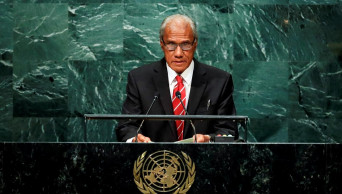TONGA
Tonga’s internet finally restored 5 weeks after big eruption
Tonga’s main internet connection to the rest of the world has finally been restored more than five weeks after a huge volcanic eruption and tsunami severed a crucial undersea cable.
Three people in Tonga were killed by the Jan. 15 tsunami, dozens of homes were destroyed and drinking water was tainted.
The fiber-optic cable is now fully operational again after being reconnected Tuesday, said Samiuela Fonua, the chairperson at Tonga Cable Ltd., the state-owned company that owns the cable.
“It’s a huge relief when you know things have come to the end and are working well,” Fonua told The Associated Press. “It’s one step forward for the country.”
Fonua said the crew aboard a repair ship replaced about 90 kilometers (56 miles) of cable that had been damaged by the tsunami. His company didn’t have enough spare cable, Fonua added, and needed to borrow some from other companies.
The fix means that Tonga Cable can now focus on repairing a second severed cable that connects some of the outer islands to the main island, Fonua said. That cable runs close to the undersea volcano.
3 years ago
Aid reaching disaster-hit Tonga brings first virus outbreak
For more than two years, the isolation of the Pacific archipelago nation of Tonga helped keep COVID-19 at bay.
But last month’s volcanic eruption and tsunami brought outside deliveries of desperately needed fresh water and medicine — and brought the virus.
Tonga is only one of several Pacific island countries to experience their first outbreaks over the past month. There is growing concern that their precarious health care systems might quickly become overburdened, and that the remoteness that once protected them may now make them difficult to help.
“Clearly when you’ve got countries that have already got a very stretched, and fragile health system, when you have an emergency or a disaster and then you have the potential introduction of the virus, that’s going to make an already serious situation immeasurably worse,” said John Fleming, the Asia-Pacific head of health for the Red Cross.
Tonga was coated with ash following the Jan. 15 eruption of the massive undersea Hunga Tonga Hunga Ha’apai volcano, then hit with a tsunami that followed.
Only three people have been confirmed killed, but several small settlements in outlying islands were wiped off the map and the volcanic ash tainted much of the drinking water.
Also read: Virus enters Tonga along with disaster aid, lockdown planned
The nation of 105,000 had reported only one case of COVID-19 since the beginning of the pandemic — a Church of Jesus Christ of Latter-day Saints missionary returning to the island from Africa via New Zealand who tested positive in October — and authorities debated whether to let international aid in.
They decided they had to, but despite strict precautions unloading ships and planes from Australia, New Zealand, Japan, Britain and China, two Tongan men who worked at the capital’s Queen Salote Wharf handling shipments tested positive on Tuesday.
The two were moved into isolation, but in tests of 36 possible contacts, one’s wife and two children also tested positive, while the others tested negative, the local Matangi Tonga news site reported.
“The highest priority now is the close contacts of these positive cases and whom they interacted with” since Jan. 29, Health Minister Saia Piukala was quoted as saying.
It was not clear how many people they might have come into contact with, but the government released a list of locations where the virus might have spread, including a church on two days, several shops, a bank on two days and a kindergarten during school hours.
Prime Minister Siaosi Sovaleni told reporters “some” of the five infected had started to show symptoms and were being quarantined at a medical facility. He imposed an open-ended lockdown starting 6 p.m. on Wednesday; one that could be particular arduous for Tongans because most have been without any internet connections since the volcanic eruption severed the only fiber optic cable to the country.
It is not yet known what variant of the virus has reached Tonga, nor who brought it in.
Sailors aboard the Australian aid ship HMAS Adelaide reported nearly two dozen infections after an outbreak on board, but authorities said it had been unloaded at a different wharf. Crew members aboard aid flights from Japan and Australia also reported infections.
Experience from elsewhere in the pandemic, especially with prevalence now of the rapid-spreading omicron variant, suggests that Tonga faces an uphill battle in trying to contain the outbreak, Indonesian epidemiologist Dicky Budiman told The Associated Press.
Also read: 23 Australians on ship delivering aid to Tonga have virus
Some 61% of Tongans are fully vaccinated, according to Our World in Data, but because the country has not yet seen any infections, there will be no natural immunity and it is not clear whether the shots were given long enough ago that they may now be less effective, Budiman said.
The global experience has been that when the virus hits such countries, the number of hospitalizations is very high, he said, recommending that the government immediately start offering booster shots and open vaccinations to younger children.
“If we race with this virus we will not win,” he said in an interview from Australia. “So we have to move forward by protecting the most vulnerable.”
This is already starting to be seen in the Solomon Islands, which reported its first community outbreak on Jan. 19. With only 11% of its population fully vaccinated, the virus has been spreading rapidly with the Red Cross reporting that less than two weeks later, there are now more than 780 recorded cases and five COVID-19 related deaths.
Elsewhere, Fiji — still reeling from damage caused by Cyclone Cody in early January — has been battling an ongoing spike in cases, fueled by omicron, and cases have been reported for the first time in Kiribati, Samoa and Palau.
Palau has nearly its entire population fully vaccinated, while Fiji has 68% and Samoa 62%, but Kiribati is only at 33%.
The key to ensuring hospitals aren’t overwhelmed is to make sure more people get shots, Budiman said.
“These countries that choose to have this COVID-free strategy, they are very vulnerable,” he said.
3 years ago
Virus enters Tonga along with disaster aid, lockdown planned
Tonga will enter a lockdown Wednesday evening after finding coronavirus infections in two port workers helping distribute aid arriving in the Pacific nation after a volcanic eruption and tsunami.
The urgent announcement by Prime Minister Siaosi Sovaleni appeared to confirm fears that accepting the aid following the disaster last month could usher in a second disaster by bringing COVID-19 into a nation that had been virus-free.
The volcanic eruption and tsunami last month tainted drinking water, severed communications and left dozens homeless. Three people died in Tonga and two in Peru after the tsunami crossed the ocean.
Ships and planes from Australia, New Zealand, Japan, Britain and China have been delivering aid. Those nations had promised to drop off their supplies of fresh water and medicine without coming into contact with anybody on the ground in Tonga, which usually requires incoming travelers to spend three weeks in quarantine.
But the threat was underscored when dozens of sailors aboard the Australian aid ship HMAS Adelaide reported infections after an outbreak. Crew members aboard aid flights from Japan and Australia also reported infections.
Read: Pfizer asks FDA to allow COVID-19 vaccine for kids under 5
News site Matangi Tonga reported that the positive test results came after officials tested 50 front-line workers at the port. The lockdown was open-ended, the site said, with updates expected from health officials every two days.
Since the pandemic began, Tonga had previously reported just a single case of the virus when a Church of Jesus Christ of Latter-day Saints missionary returning from Africa tested positive in October after flying home via New Zealand.
Tonga and several other small Pacific nations, including Kiribati and the Solomon Islands, were among the last places on the planet to have avoided any virus outbreaks, thanks to their remote locations and strict border controls. But that’s changed in the last few weeks as their defenses appeared no match against the highly contagious omicron variant.
The lockdown in Tonga comes as many homes and businesses remain without internet access after the tsunami severed the sole fiber-optic cable that connects Tonga to the rest of the world. Officials are hoping repairs will be completed within a week or two.
About 61% of Tonga’s 105,000 people are fully vaccinated, according to Our World in Data.
3 years ago
23 Australians on ship delivering aid to Tonga have virus
Nearly two dozen sailors on an Australian military ship going to deliver aid to Tonga have tested positive for the coronavirus, officials said Tuesday, raising fears they could bring COVID-19 to a Pacific nation that has so far managed to avoid any outbreaks.
Australian Defense Minister Peter Dutton said his government was working with Tongan authorities to keep the ship at sea and make sure there is no threat to Tonga’s 105,000 residents.
Tongan authorities have been wary that accepting international aid could usher in a bigger disaster than the huge eruption of an undersea volcano 10 days ago. The eruption triggered a tsunami that destroyed dozens of homes, and volcanic ash has tainted drinking water.
Since the pandemic began, Tonga has reported just a single case of COVID-19 and has avoided any outbreaks. It’s one of the few countries in the world currently completely virus free. About 61% of Tongans are fully vaccinated, according to Our World in Data.
Australian officials said 23 crew members were infected on the HMAS Adelaide, which left Brisbane on Friday.
“They need the aid desperately, but they don’t want the risk of COVID,” Dutton told Sky News. “We will work through all of that as quickly as we can.”
It’s the second aid shipment from Australia in which at least one crew member tested positive. A C-17 Globemaster military transport plane was earlier turned around midflight after somebody was diagnosed.
Meanwhile, a cable company official said Tonga’s main island could have its internet service restored within two weeks, although it may take much longer to repair the connection to the smaller islands.
Read: Soldiers declare military junta in control in Burkina Faso
The single undersea fiber-optic cable which connects the Pacific nation to the outside world was severed after the eruption and tsunami.
That left most people unable to connect with loved ones abroad. For days, people couldn’t get through on their phones, by email, or through social media.
Since then, Tonga’s Digicel has been able to restore international call services to some areas by using satellite connections. Some people have been able to send emails or get limited internet connectivity.
Samieula Fonua, who chairs the board at Tonga Cable Ltd., the state-owned company which owns the fiber-optic cable, said a repair ship had left from Papua New Guinea and was due to stop over in Samoa by Monday to pick up supplies. It should then arrive in Tonga by Feb. 1.
Fonua said the CS Reliance had a crew of about 60 aboard, including engineers, divers and medical staff. He said its equipment included a robot which could assess the cable on the seabed.
TECHNOLOGYDC, 3 states sue Google saying it invades users' privacyBelarus hacktivists target railway in anti-Russia effortIn global 5G race, European Union is told to step up pace23 Australians on ship delivering aid to Tonga have virusFonua said preliminary estimates indicated the break in the cable was located about 37 kilometers (23 miles) offshore from the main island of Tongatapu. He said that all going well, the crew should be able to repair the cable by Feb. 8, restoring the internet to about 80% of Tonga’s customers.
The cable runs from Tonga to Fiji, a distance of about 800 kilometers (500 miles), and was first commissioned in 2013 at a cost of about $16 million. It was financed through grants from the World Bank Group and Asian Development Bank, and increased Tonga’s internet capacity fivefold.
But like many small Pacific countries, Tonga relies heavily on a single cable to stay connected and has little in the way of a back-up plan. Three years ago, a cable break believed to have been caused by a ship dragging its anchor also led to weeks of disruptions.
Read: Global Covid cases top 354 million
A second, domestic fiber-optic cable that connects Tonga’s smaller islands to the main island could prove much more difficult to repair. Fonua said that cable runs near the undersea volcano which erupted and may have been severely damaged. It might need extensive repairs or even a replacement, he said.
Fonua said the focus was on fixing the main international cable, and they could deal with the domestic connections “at a later time.”
He said Tongans had been somewhat understanding of the communication disruptions caused by the disaster, which killed three people, destroyed dozens of homes and tainted water supplies with volcanic ash.
“People are calm. Coming out of a total blackout, just being able to call outside and send an email has settled them a bit,” Fonua said. “By the time they start getting more frustrated, I’m hoping we’ll have the cable connected by then.”
3 years ago
First aid flights leave for Tonga after big volcano eruption
The first flights carrying fresh water and other aid to Tonga were finally able to leave Thursday after the Pacific nation's main airport runway was cleared of ash left by a huge volcanic eruption.
A C-130 Hercules military transport plane left New Zealand carrying water containers, kits for temporary shelters, generators, hygiene supplies and communications equipment, New Zealand's Foreign Minister Nanaia Mahuta said.
Australia also sent a C-17 Globemaster transport plane with another to follow that were carrying humanitarian supplies. The flights were all due to arrive in Tonga on Thursday afternoon.
Read:Tsunami threat recedes from huge Pacific volcanic eruption
The deliveries will be done with no contact because Tonga is desperate to make sure foreigners don't bring in the coronavirus. It has not had any outbreaks of COVID-19 and has reported just a single case since the pandemic began.
"The aircraft is expected to be on the ground for up to 90 minutes before returning to New Zealand,” Defense Minister Peeni Henare said.
Japan also said it would send emergency relief, including drinking water and equipment for cleaning away volcanic ash. Two Hercules aircraft and a transport vessel carrying two CH-47 Chinook helicopters would leave possibly Thursday, the Defense Ministry said.
Japanese Defense Minister Nobuo Kishi told reporters that his ministry “will do everything we can for the disaster-hit people of Tonga.”
U.N. humanitarian officials report that about 84,000 people — more than 80% of Tonga’s population — have been impacted by the volcano’s eruption, U.N. spokesman Stéphane Dujarric said, pointing to three deaths, injuries, loss of homes and polluted water.
Communications with Tonga remain limited after Saturday's eruption and tsunami appeared to have broken the single fiber-optic cable that connects Tonga with the rest of the world. That means most people haven’t been able to use the internet or make phone calls abroad, although some local phone networks are still working.
A navy patrol ship from New Zealand is also expected to arrive later Thursday. It is carrying hydrographic equipment and divers, and also has a helicopter to assist with delivering supplies.
Officials said the ship's first task would be to check shipping channels and the structural integrity of the wharf in the capital, Nuku'alofa, following the eruption and tsunami.
Another New Zealand navy ship carrying 250,000 liters (66,000 gallons) of water is on its way. The ship can also produce tens of thousands of liters of fresh water each day using a desalination plant.
Three of Tonga’s smaller islands suffered serious damage from tsunami waves, officials and the Red Cross said.
Read:Indonesia raises Semeru volcano alert, fearing new eruption
The U.N.’s Dujarric said “all houses have apparently been destroyed on the island of Mango and only two houses remain on Fonoifua island, with extensive damage reported on Nomuka.” He said evacuations are underway for people from the islands.
According to Tongan census figures, Mango is home to 36 people, Fonoifua is home to 69 people, and Nomuka to 239. The majority of Tongans live on the main island of Tongatapu, where about 50 homes were destroyed.
Dujarric said the most pressing humanitarian needs are safe water, food and non-food items, and top priorities are reestablishing communication services including for international calls and the internet.
Tonga has so far avoided the widespread devastation that many initially feared.
3 years ago
Volcanic ash delays aid to Tonga as scale of damage emerges
Thick ash on an airport runway was delaying aid deliveries to the Pacific island nation of Tonga, where significant damage was being reported days after a huge undersea volcanic eruption and tsunami.
New Zealand’s military is sending much-needed drinking water and other supplies, but said the ash on the runway will delay the flight at least a day. A towering ash cloud since Saturday’s eruption had prevented earlier flights. New Zealand also sent a navy ship to Tonga Tuesday with another planned to leave later in the day and pledged an initial 1 million New Zealand dollars ($680,000) toward recovery efforts.
Australia sent a navy ship from Sydney to Brisbane to prepare for a support mission if needed.
Communications with Tonga have been extremely limited, but New Zealand and Australia sent military surveillance flights to assess the damage on Monday, with aerial photos showing the vibrant Tongan landscape transformed by the ash into a gray moonscape.
U.N. humanitarian officials and Tonga’s government “report significant infrastructural damage around Tongatapu,” U.N. spokesman Stephane Dujarric said.
“There has been no contact from the Ha’apai Group of islands, and we are particularly concerned about two small low-lying islands — Mango and Fonoi — following surveillance flights confirming substantial property damage,” Dujarric said.
Read: Hong Kong to cull 2,000 hamsters as some test COVID-positive
New Zealand’s High Commission in Tonga also reported “significant damage” along the western coast of the main island of Tongatapu, including to resorts and along the waterfront area. The commission said Tonga police had confirmed two deaths from the tsunami, including one who was a British national.
Satellite images captured the spectacular eruption, with a plume of ash, steam and gas rising like a giant mushroom above the South Pacific. Tsunami waves of about 80 centimeters (2.7 feet) crashed into Tonga’s shoreline, and crossed the Pacific, causing minor damage from New Zealand to Santa Cruz, California. The eruption set off a sonic boom that could be heard as far away as Alaska.
Two people drowned in Peru, which also reported an oil spill after waves moved a ship that was transferring oil at a refinery.
Family said British woman Angela Glover, 50, died after being swept away by a wave in Tonga.
Nick Eleini said his sister’s body had been found and that her husband survived. “I understand that this terrible accident came about as they tried to rescue their dogs,” Eleini told Sky News. He said it had been his sister’s life dream” to live in the South Pacific and “she loved her life there.”
The explosion of the Hunga Tonga Hunga Ha’apai volcano, about 64 kilometers (40 miles) north of Nuku’alofa, was the latest in a series of dramatic eruptions. In late 2014 and early 2015, eruptions created a small new island and disrupted air travel to the Pacific archipelago.
Earth imaging company Planet Labs PBC had watched the island after a new vent began erupting in late December. Satellite images showed how drastically the volcano had shaped the area, creating a growing island off Tonga.
The U.N. World Food Program is exploring how to bring in relief supplies and more staff and has received a request to restore communication lines in Tonga, Dujarric said.
Read: Satellite photos show aftermath of Abu Dhabi oil site attack
One complicating factor is that Tonga has managed to avoid outbreaks of COVID-19. New Zealand said its military staff were vaccinated and willing to follow Tonga’s protocols.
New Zealand’s military said it hoped the airfield in Tonga would be opened either Wednesday or Thursday. The military said it had considered an airdrop but that was “not the preference of the Tongan authorities.”
Communications with the island nation is limited because the single underwater fiber-optic cable that connects Tonga to the rest of the world was likely severed in the eruption. The company that owns the cable and repairs could take weeks.
Samiuela Fonua, who chairs the board at Tonga Cable Ltd., said the cable appeared to have been severed about 10 to 15 minutes after the eruption. He said the cable lies atop and within coral reef, which can be sharp.
Fonua said a ship would need to pull up the cable to assess the damage and then crews would need to fix it. A single break might take a week to repair, he said, while multiple breaks could take up to three weeks. He added that it was unclear yet when it would be safe for a ship to venture near the undersea volcano to undertake the work.
A second undersea cable that connects the islands within Tonga also appeared to have been severed, Fonua said. However, a local phone network was working, allowing Tongans to call each other. But he said the lingering ash cloud was continuing to make even satellite phone calls abroad difficult
3 years ago
Tonga's prime minister, who nurtured democracy, dies at 78
Wellington, Sep 12, (AP/UNB) — Tongan Prime Minister 'Akilisi Pohiva, who helped wrest power from the royal family and bring greater democracy to the small Pacific island nation, died Thursday. He was 78.
6 years ago

.jpg)








